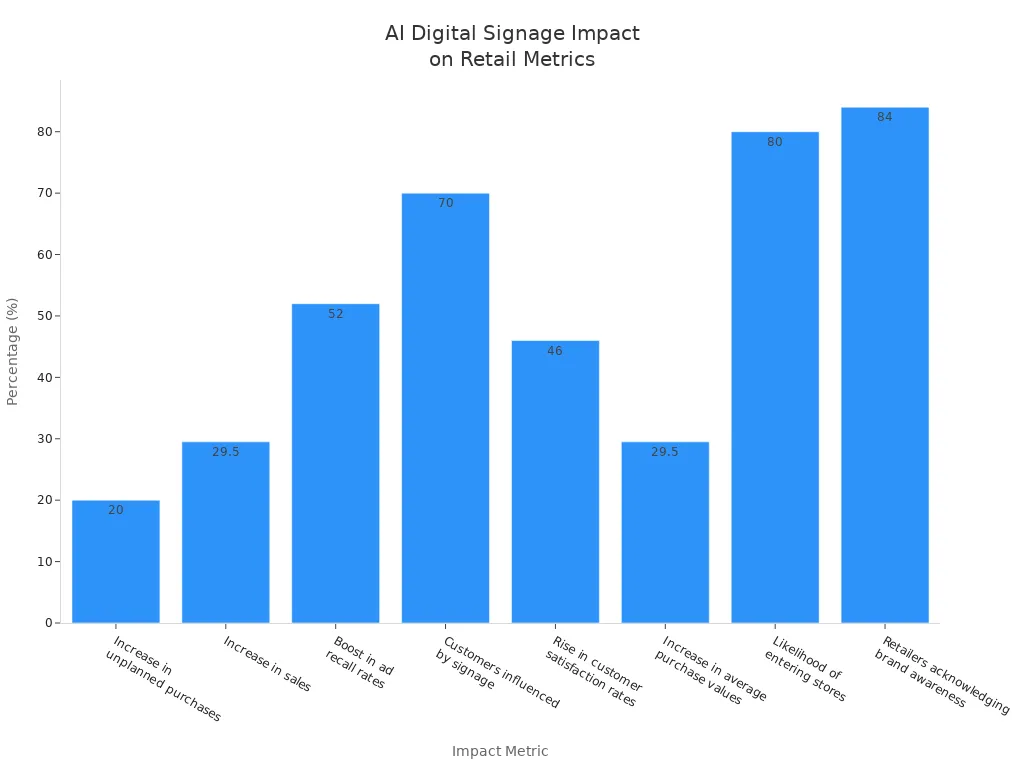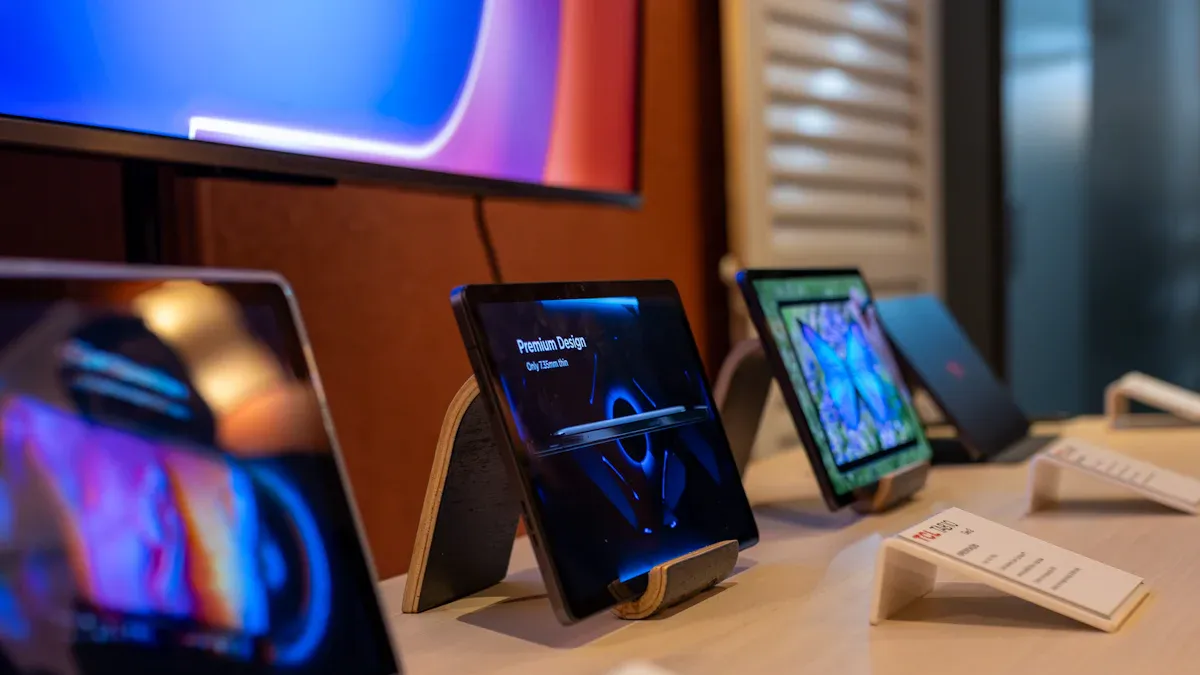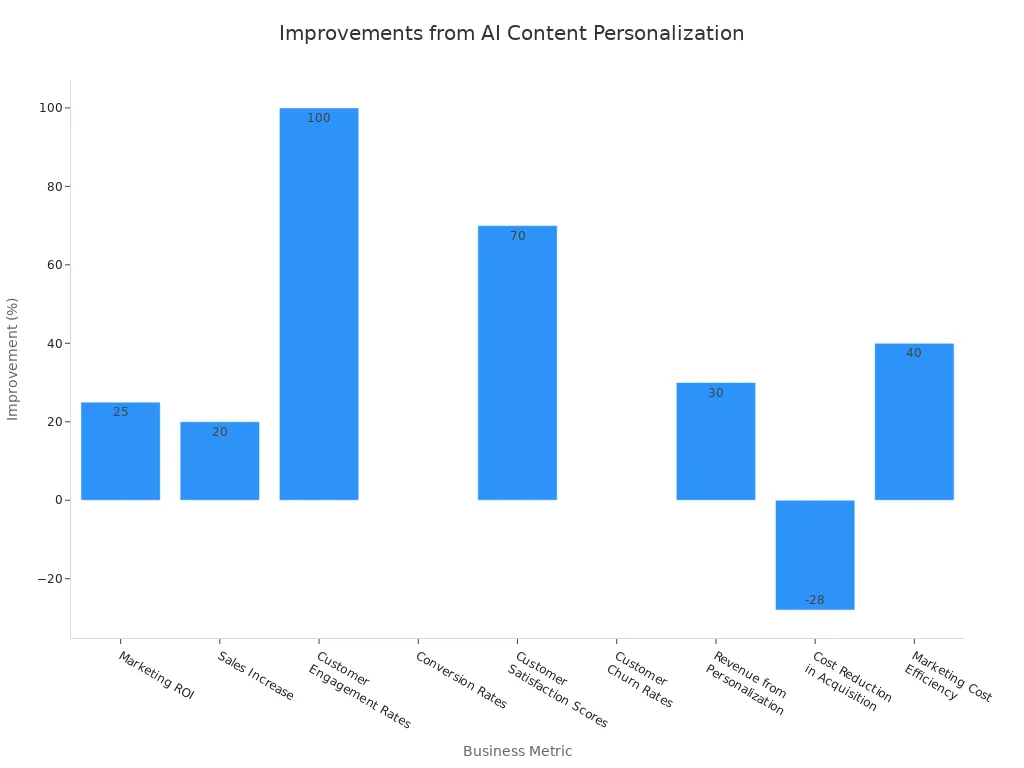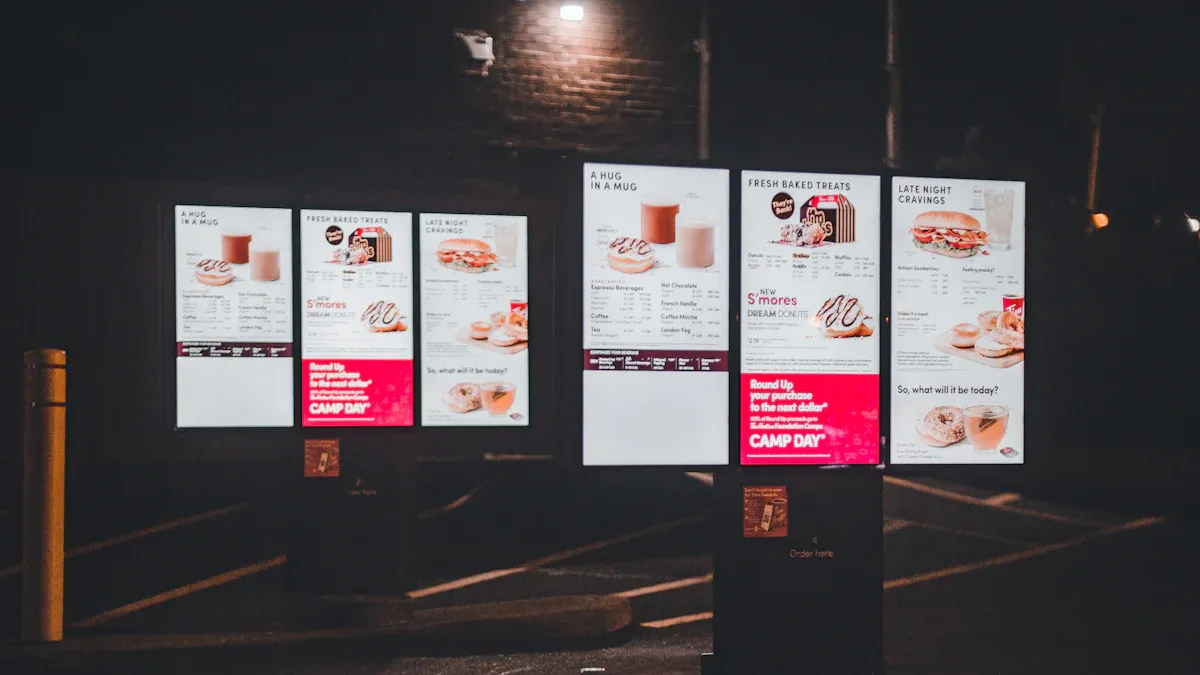Ai powered digital signage in store

You see digital signs in stores changing how you shop. These ai powered displays grab your attention and help you find deals fast. Many shoppers notice them, and stores report higher sales and more people walking in.
Statistic Description | Value |
|---|---|
Increase in unplanned purchases | 20% |
Increase in sales | 29.5% |
Boost in ad recall rates | 52% |
Customers influenced by digital signage | 70% |
Rise in customer satisfaction rates | 46% |
Increase in average purchase values | 29.5% |
Likelihood of customers entering stores | 80% |
Retailers acknowledging enhanced brand awareness | 84% |

Key Takeaways
AI-powered digital signage increases customer engagement by showing personalized offers and product recommendations based on your interests.
Stores using this technology report higher sales, with an average increase of 29.5% and a boost in customer satisfaction by 46%.
Real-time content changes keep your shopping experience fresh, adapting displays based on crowd size and individual behavior.
Analytics from digital signage help retailers optimize product placement and improve store layouts, enhancing your overall shopping experience.
Privacy is prioritized, with stores following strict regulations to protect your data while using anonymous information for personalization.
Ai powered in-store experience

Customer engagement
You walk into a store and see screens that seem to know what you want. These ai powered digital signs use sensors to notice when you approach. The display changes to show products that match your interests. You can tap the screen to learn more or scan a code for a special offer. Retailers use smart signage to understand how you interact with products. This helps them make better choices about what to show and where to place items.
Did you know? Interactive signage can make waiting feel shorter by up to 35%. You stay entertained, and your shopping experience feels smoother.
Many stores invest in digital signage to keep you engaged. In fact, 60% of retailers now use multi-purpose technologies to improve customer engagement. You might see self-service screens that let you browse products or find your way around the store. These features connect your online and offline shopping, making your visit more personal and fun.
Evidence | Description |
|---|---|
Prefers shopping in physical stores, showing a need for engaging experiences. | |
56% of Gen Z | Wants shopping to be fun, so stores add interactive elements. |
30% growth | More money spent on in-store advertising, showing a shift to digital engagement. |
You help shape the store by how you move and interact. Retailers use real-time insights to adjust layouts and product placement, making your visit better each time.
Real-time content
Ai powered digital signage does not just show the same message all day. It changes what you see based on who is nearby and what is happening in the store. Sensors track crowd size and adjust promotions when more people are present. If you stand close to a screen, it might show deals for your age group or suggest products based on your behavior.
Sensor integration lets the display react to your movements and the store environment.
Proximity detection changes content when you get closer to the screen.
Behavioral cues respond to your gestures, making the experience interactive.
EasySignage AI gives stores real-time data about who is looking at the screens and how they react. This helps businesses make messages more relevant and engaging. You see personalized recommendations and special discounts that match your preferences. If you need help, virtual assistants can offer instant support right on the screen.
Evidence | Description |
|---|---|
Personalized Recommendations | Messages and promotions match your interests. |
Dynamic Pricing | Prices change based on demand and your behavior. |
Immediate Customer Support | You get help right away, making shopping easier. |
Smart Mirrors | You can see how clothes look without trying them on. |
Virtual Try-Ons | You get a digital fitting room experience. |
RFID and Beacon Systems | The store personalizes your experience in real time. |
Ai powered signage turns static displays into dynamic, interactive platforms. Stores use real-time analytics and machine learning to keep content fresh and interesting. You get a shopping experience that feels unique every time you visit.
Key features and benefits
Analytics and insights
You can see how ai powered digital signage gives you and store owners valuable information. These systems track who looks at the screens, how long they stay, and which displays get the most attention. This helps stores understand what works best and where to place products or signs for the biggest impact.
Description | |
|---|---|
Viewer Analytics | Shows live data on who looks at displays and how many people stop to check them. |
Demographic Analysis | Detects age and gender from up to 6 meters away for better customer engagement. |
Foot Traffic Monitoring | Tracks how many people pass by, how long they stay, and where they go in the store. |
Real-Time Content Optimization | Changes what is shown based on time, place, and customer type to boost engagement. |
Stores use this data to make smart choices. For example, heatmaps show where shoppers gather, so staff can move products or signs to those spots. Knowing when the store gets busy helps managers schedule the right number of workers. You get a smoother shopping trip, and stores run more efficiently.
Personalization
Personalization makes your shopping experience feel unique. Ai powered signage can recognize returning customers and show offers just for you. It suggests products based on what you have bought before or what you seem interested in now.
Method | Description |
|---|---|
Personalized Offers | Shows deals that match your shopping habits. |
Product Recommendations | Suggests items based on your past purchases or interests. |
Real-time Content Adaptation | Changes messages instantly based on who is watching and how they behave. |
You see promotions that matter to you, not just random ads. This approach leads to higher sales and happier customers. In fact, stores report up to 30% higher satisfaction scores and 20% more sales when they use personalized content.

Security enhancements
Security is important for both you and the store. Ai powered digital signage helps keep everyone safe by watching for unusual activity. The system can send real-time alerts to staff if it notices something suspicious, like someone acting strangely near a display.
Feature | Description |
|---|---|
Real-Time Alerts | Notifies staff right away about possible security issues. |
Automated Anomaly Detection | Spots odd behavior, such as theft, without needing a person to watch all the time. |
Integration with POS Systems | Connects with checkout data to quickly check if something unusual happens, saving time and effort. |
This technology lets stores focus on real problems instead of checking every small issue. You can shop with peace of mind, knowing the store uses smart tools to protect you and your information.
Practical retail applications

Product recommendations
You see product suggestions on screens as you walk through the store. These recommendations use ai powered technology to match your interests and shopping habits. You get ideas for new items based on what you like or what you have bought before. Retailers use generative AI to personalize these suggestions, making your shopping trip easier and more fun. For example, Mastercard's Shopping Muse can turn your questions into tailored product ideas. Amazon uses similar technology, and it drives over a third of their sales. In physical stores, systems like Footprints AI predict what you might want next by watching how you move and what you look at. Nearly all retail businesses now use digital signage, and most see higher sales and more customer engagement.
Personalized product suggestions based on your preferences
Interactive displays that let you explore new items
Real-time updates as you browse different sections
Queue management
You do not like waiting in long lines. Stores use ai powered digital signage to help you avoid this problem. These systems watch how many people are in each line and guide you to the shortest one. You see real-time updates on screens, so you know where to go. The technology predicts busy times and helps staff move to where they are needed most.
Feature | Traditional Systems | AI Camera Systems |
|---|---|---|
Customer Flow | Single line or counters | Real-time monitoring |
Wait Time Estimation | Manual or none | AI prediction |
Staff Allocation | Fixed schedules | Automated reallocation |
Dwell time analysis for better staff placement
Predictive analytics for busy periods
You feel valued when stores use these systems. You save time and enjoy a smoother shopping experience.
Campaigns and promotions
You notice special deals and events on digital screens. Stores use ai powered signage to launch flash sales, promote new products, and share important updates. The system can change prices and offers quickly, so you always see the latest deals. It checks for errors and keeps promotions accurate across all locations.
Evidence Point | Description |
|---|---|
Automation of Processes | Quick updates for sales and promotions |
Real-time Insights | Dynamic changes based on sales patterns |
Compliance Monitoring | Checks for pricing and promotion errors |
You also get help finding your way around. Interactive screens show you where to go for events or new products. Voice-activated displays answer your questions and help you search for items. These features make your visit more enjoyable and help you find what you need fast.
Implementation and privacy
Data strategy
You need a strong data strategy to get the most from digital signage. Start by finding the busiest spots in your store. Place screens where people gather and move often. Use AI analytics to see what content works best. Change your messages based on customer interests and the time of day.
Use heat mapping and foot traffic analysis.
Tailor content to match your audience in real time.
Let AI adjust promotions for holidays or busy hours.
Shift to video content if it gets more attention.
Update ads quickly to keep them fresh and relevant.
AI algorithms can spot trends and help you show the right message at the right time. This makes your signage more effective and keeps shoppers interested.
Privacy and compliance
You must protect customer data and follow privacy laws. Many countries have strict rules about how you collect and use information. Here is a quick look at some key regulations:
Regulation | Key Considerations |
|---|---|
FTC | Requires strong data security and sector-specific rules. |
GDPR | Needs clear consent and gives people rights over their data. |
PIPEDA | Focuses on consent and transparency. |
CPRA | Demands privacy checks and easy opt-out options. |
To stay compliant, always get clear consent before collecting data. Use anonymous data collection and avoid facial recognition. Keep shopper information on-site and process it with edge computing. This keeps personal details safe and private.
Tip: Regularly review your privacy policies and train staff on data protection.
Deployment steps
You can follow these steps to deploy ai powered digital signage:
Assess each store’s needs and check for power and network access.
Choose the right screens and place them for easy viewing.
Set up AI software for content scheduling and analytics.
Test the system to make sure it works in your store’s environment.
Train your team to manage and update content.
Monitor performance and adjust based on customer feedback.
Review compliance and security often.
Some challenges may come up, like tricky installations or unique store layouts. You may need IT experts to help with setup and to meet safety standards. Good planning helps you avoid common problems and get the best results.
You see how ai powered digital signage changes your shopping experience. Stores use smart displays to show you products you like and help you find deals. Businesses track what works and improve their results with better analytics. You get faster service and more personal offers. Looking ahead, you will see displays that use touchless controls, voice commands, and even augmented reality. These new features will make shopping easier and more fun.
AI creates tailored content for every shopper.
Touchless technology and AR will shape future retail.
FAQ
How does AI-powered digital signage know what to show me?
AI uses sensors and data to learn about your interests. It can track your movements and past shopping habits. The system then shows you products or deals that match what you like.
Is my personal information safe with these systems?
You stay protected because stores use anonymous data. They follow privacy laws and avoid storing personal details. Most systems process information on-site to keep your data secure.
Can digital signage help if I need assistance in the store?
Yes! Many screens offer virtual assistants. You can ask questions or get directions. Some displays even let you scan a code for instant help.
What happens if the technology stops working?
If a screen goes down, staff can update or fix it quickly. Stores often have backup systems. You will still find help from employees or other signs.
See Also
Exploring The Advantages Of AI-Enhanced Vending Machines
The Future Of Retail Lies In AI-Driven Stores
Transforming Retail: The Impact Of Smart Vending Machines
Revolutionizing Online Retail With AI-Driven Management Tools
Boosting Office Efficiency Through Intelligent Vending Solutions
